B
|
East: |
New York Songlines: BroadwayW 90th | | W 89th| W 88th | W 87th | W 86th | W 85th | W 84th | W 83rd | W 82nd | W 81st | W 80th | | W 79th| W 78th | W 77th | W 76th | W 75th | W 74th | W 73rd (The Ansonia) | W 72nd | W 71st | W 70th | W 69th| W 68th | W 67th | W 66th | W 65th (Lincoln Square) | W 64th | W 63rd | W 62nd | W 61st | W 60th | W 59th (Columbus Circle) | W 58th | W 57th | W 56th | W 55th | W 54th (Ed Sullivan) | W 53rd | W 52nd | W 51st | W 50th | W 49th (Brill Building) | W 48th | W 47th (Duffy Square) | W 46th (Times Square) | W 45th | W 44th | W 43rd | W 42nd/7th Ave | W 41st | W 40th | W 39th | W 38th | W 37th | W 36th | W 35th (Herald Square/Macy's) | W 34th/6th Ave | W 33rd | W 32nd (Koreatown) | W 31st | W 30th | W 29th | W 28th | W 27th | W 26th | W 25th (Worth Square) | W 24th (Madison Square) | 23rd/5th Ave (Flatiron) | E 22nd | E 21st | E 20th | E 19th | E 18th | E 17th (Union Square) | E 14th/4th Ave | E 13th | E 12th (The Strand) | E 11th (Grace Church) | E 10th | E 9th | E 8th | Waverly Place | Washington Place | 4th St | 3rd/Great Jones | Bond | Bleecker | Houston (SoHo) | Prince | Spring | Broome | Grand | Howard | Canal | Lispenard | Walker | White | Franklin | Leonard | Catherine | Worth (Federal Plaza) | Thomas | Duane | Reade | Chambers (City Hall) | Warren | Murray | Park Place (Woolworth Tower) | Barclay/Park Row | Vesey/Ann (St. Paul's) | Fulton | Dey/John | Cortlandt/Maiden | Liberty | Cedar | Pine | Thames | Wall (Trinity Church) | Rector | Exchange | Morris | Beaver | Battery/Stone (Charging Bull/Bowling Green/Customs House)Broadway was originally an Indian trail, called the Wickquasgeck Road, that followed the ridge of the hilly island of Manahatta. The Dutch settlers called it Heere Straat, or High Street, because of its elevated position; one of several other names it was known by was the Broad Wagon Way, which presumably was the origin of its present appellation. Above what is now Union Square it was known as the Bloomingdale Road, after a village located on the present-day Upper West Side. Broadway now runs all the way to Albany, making it the longest street in the world. It may also be the street most sung about, immortalized in countless songs like "Lullaby of Broadway," "On Broadway" and "A Lamb Lies Down on Broadway." It's said that there's a broken heart for every light on Broadway—or is it a broken light for every heart? |
|
|
|
|
|
|
|
|
|
|
|
|
|
|
|
|
|
|
|
|
|
|
|
|
|
|
|
|
|
|
|
|
|
|
|
|
|
|
|
|
|
|
|
|
|
|
|
|
|
|
|
|
|
|
|
|
|
|
|
|
|
|
|
|
|
|
|
|
|
|
|
|
|
|
|
|
|
|
|
|
|
|
|
|
|
|
|
|
|
|
|
|
|
|
|
|
|
|
|
|
|
|
|
|
|
|
|
|
|
|
|
|
|
|
|
|
|
|
|
|
|
|
|
|
|
|
|
|
|
|
|
|
|
|
|
|
|
|
|
|
|
|
Columbus Circle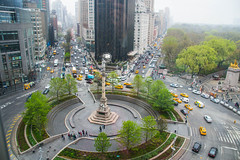
A roundabout honoring one of
history's greatest monsters.
It's not that he should be held responsible for all of Europe's
effects on a New World that he didn't even realize he had
found;
Speaking of monsters, the Stay-Puft Marshmallow Man menaces Columbus Circle in Ghostbusters. And Travis Bickle tries to assassinate a political candidate here in Taxi Driver. The circle got a major makeover in 2005 to make it more hospitable and accessible to pedestrians. Above Columbus Circle is the Lincoln Square neighborhood; below is Hell's Kitchen. |
|
|
|
|
|
|
|
|
|
|
|
|
|
|
|
|
|
|
|
|
|
|
|
|
|
|
|
|
|
|
|
|
|
|
|
|
|
|
|
|
|
|
|
|
|
|
|
|
|
|
|
|
|
|
|
|
|
|
|
|
|
|
|
|
|
|
|
|
|
|
|
|
|
|
|
|
|
|
|
|
|
|
|
|
|
|
|
|
|
|
|
|
|
|
|
|
|
|
|
|
|
|
|
|
S <=== 6TH AVENUE |
|
|
|
In the movie Hospitality, made in 1923 but set in 1830, Buster Keaton on a proto-bicycle waits
at this intersection—then a crossing of two country roads—for a buggy to pass. "Gettin' dangerous out
here," a sheriff remarks.
|
|
|
|
|
|
|
|
|
|
|
|
|
|
|
|
|
|
|
|
|
|
|
|
|
|
|
|
|
|
|
|
|
|
|
|
S <=== 5TH AVE / E 23RD ST ===> E |
|
|
|
|
|
|
|
|
|
|
|
|
|
|
|
|
|
|
|
|
|
|
|
|
Union Square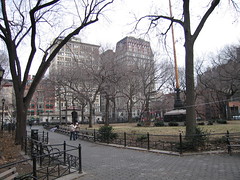
Union Square was not named for labor or for the North, but for
the fact that Broadway meets and briefly converges with the Bowery
(now 4th Avenue and Park), once Broadway's rival as NYC's main street. In the
city plan of 1811, Broadway was supposed to be eliminated north of
14th Street, permanently uniting it with 4th Avenue. Fortunately,
NYC was unable to raise money to reroute Broadway, saving Manhattan
above Downtown from complete predictability.
The square has a rich political history: 250,000 gathered here to support the Union during the Civil War (1861), the largest crowd ever assembled in North America up to that point. Here were the first U.S. labor day parade (1882), Emma Goldman's arrest for telling unemployed to steal bread (1893), a funeral march for Triangle Shirtwaist Fire victims (1911), protests against Sacco & Vanzetti's execution (1927) and the Rosenbergs' (1953). After the destruction of the World Trade Center, Union Square became the site of an impromptu memorial and peace vigil. The parking lot at the north end of the park hosts Union Square
Greenmarket, Manhattan's biggest farmers' market.
It used to be used for weekly recreations of medieval combat by the
Society for Creative Anachronism.

The steps at the south end of Union Square have become one
of Manhattan's great public spaces—used by
skateboarders, break dancers, political agitators and
people just hanging out on the steps. The
Critical Mass
bicycle rallies gather here on the last Friday of every month,
though they've largely been suppressed by extra-constitutional
NYPD action. There's a craft fair here every year in December.
|
The northern boundary of the Village. |
|
|
|
|
|
|
|
|
|
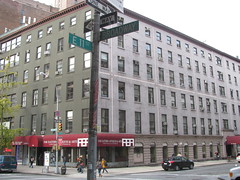
799 (cor- ner): Was the St. Denis
Hotel (1848- 1917), one of NYC's most elegant.
Guests included Lincoln, Grant, P.T. Barnum, Sarah Bernhardt,
Buffalo Bill Cody. Alexander Graham Bell
795: Was the offices of Grove Press, which helped fight censorship of literature by publishing Lady Chatterly's Lover and Tropic of Cancer. 791: Poet and art critic Frank O'Hara had an all-white loft here; this was
his home when he was killed in 1966, run over by a beach buggy on
Fire Island.
Brittany Hall
787: NYU dorm was formerly the Brittany Hotel, which has housed columnist Walter Winchell, actor Al Pacino and rocker Jerry Garcia. The penthouse, now a study lounge, was once a speakeasy. The ground floor features Broadway Windows, displays of often interesting student art. |
B
|
East:824 (corner): Proctor Galleries Fine Antiques is in Hewlett House, a 1963 white-brick building. 820: Bon Vivant Diner is in a building that was uglified in 2007. 818: The site of John Morrisey's Gambling Hall, noted for its imperviousness to raids, "thanks to an ingenious basement vault...that permitted all the gambling apparatus and the bank to be hidden rapidly behind a false wall."—Low Life. 816: Place de Vosges, named for an old square in Paris, is in a crumbling 3-1/2 story rowhouse from 1910. 814: Midtown Antiques is in a Greek Revival townhouse. Also here are Rafik Video and Digitpost. 812: Turbulence antiques, founded 1984, is in a c. 1900 building with layers of pillars. 810: Ariyoshi Sake Bar is in a seven-story neo-Gothic building, built 1907. The Renwick808: Halloween Adventure, a costume
Grace Church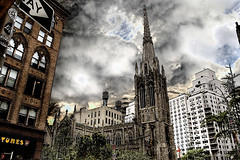
800- 804: One of NYC's
archi- tectur- al jewels,
erected 1843-46.
James Renwick, Jr.—a member of the Brevoort
family, whose land this
once was—won a contest to design it, his first
professional work; Calvert Vaux, co-designer of
Central Park, landscaped the
garden in 1881.
Corner: The church yard was once Fleischmann's Vienna Model Bakery, whose daily donations of unsold bread gave rise to the term "breadline." |
|
|
|
|
9th
Street between Broadway and 4th Avenue was renamed for the Wanamaker's
stores that it separated.
|
|
|
|
|
<
|
Tisch School of the Arts715: NYU school named for media mogul Laurence Tisch is arguably the country's top film school; among its alums are directors Martin Scorsese, Oliver Stone, Spike Lee, Joel Coen, Jim Jarmusch, Ang Lee and George C. Wolfe; actors Alec Baldwin, Billy Crystal, John Leguisamo and Adam Sandler; and playwright Tony Kushner. Built on the site of the New York Hotel
(1844-95), believed to be a hotbed of Confederate spies during
the Civil War. It introduced room service and the ala carte menu.
Bookseller August Brentano got his start with a newsstand
here in 1853.
NYU's Gallatin School of Individualized Study. Named for Albert Gallatin, Jefferson's treasury secretary, who helped found NYU. My friend Kimberly Phillips-Fein teaches here. 713: Writer Bret Harte took an apartment at this address in 1875. |

Corner: NYU's Meyer Hall of Physics.
At one point the plan was to have all
of NYU's buildings be this reddish color.
Corner (1 W 4th): Hebrew Union College's Brookdale Center, housing the Jewish Institute of Religion (founded 1922) and the School of Sacred Music (1948). |
B
|
East:Astor Place Building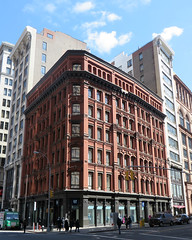 Yet another reason to dislike the "Sculpture
for Living"—the glass tower across from Cooper
Union—is that it ripped off the address
of this building—1 Astor Place—which had been happily using it
for more than a century. This red-brick Victorian beauty
went up in 1881 with the
same builder—lawyer
Orlando Potter—and
architectural team—Starkweather & Gibbs—
who later produced the Potter Building on Park Row.
It was a very early example of the use of
terra cotta
for ornamentation—colored to resemble the
then-ubiquitous brownstone. (Potter's buildings so
popularized terra cotta that he went on to
start the New York Terra Cotta Company.)
Yet another reason to dislike the "Sculpture
for Living"—the glass tower across from Cooper
Union—is that it ripped off the address
of this building—1 Astor Place—which had been happily using it
for more than a century. This red-brick Victorian beauty
went up in 1881 with the
same builder—lawyer
Orlando Potter—and
architectural team—Starkweather & Gibbs—
who later produced the Potter Building on Park Row.
It was a very early example of the use of
terra cotta
for ornamentation—colored to resemble the
then-ubiquitous brownstone. (Potter's buildings so
popularized terra cotta that he went on to
start the New York Terra Cotta Company.)
|
Broadway was paved to this point by 1809.
|
740 (corner): Vitamin Shoppe, a chain with an eye for good architecture. Also houses Papa Beard Sweets, an Asian cream-puff franchise. This area, stretching east to what is now Cooper Square, was from 1806-55 the Vauxhall Garden, a popular amusement center featuring "mead booths, flying horses, fireworks, concerts, etc." (Historical Tour of... Broadway). In 1942, the newly formed Manhattan Savings Bank was headquartered here. 742: Village Tannery 740: Rubber Sole shoes, part of the Yellow Rat Bastard alterno-clothing complex 738: The Beez Neez clothes, one of many sportswear outlets along this stretch of Broadway 736: Tempo clothes, owned by Yellow Rat Bastard. At this address and its two neighbors to the south lived Mary Mason Jones—the inspiration for Mrs. Mingott in The Age of Innocence— and her two sisters, who between them had married two brothers and the brothers' cousin. The houses had separate entrances but with grand interiors that could be combined. 732: This 1882 building says ''Treffurth's'' near the cornice, marking the former home of a noted restaurant. More recently it housed XOXO clothes. Upstairs is Otakuden, an anime shop. 730: Headquarters of labor-owned Amalgamated Life Insurance; note the brass cockatrices above the doors. The building is on the site of the Broadway Atheneum, a theater converted from the Unitarian Church of the Messiah by A.T. Stewart in 1865. It also ran under the names Daly's New Fifth-Avenue Theater, Fox's Broadway Theater, The Globe and Harrigan & Hart's New Theatre Comique. Burned down in 1884. 724: The address of the Medical College for Women and Hospital for Women and Children, a homeopathic institution opened in 1862 with support from Elizabeth Cady Stanton. Also the address of the Church of the Messiah. 720: Jimmy Jazz clothes 718: The new home of Canal Jeans, which was the cool place to shop for clothes in the 1980s. In 1980, Unique Clothing Warehouse opened here, marking the rebirth of this stretch of Broadway as a hip retail zone; artist Jean-Michel Basquiat was an employee here. (It went bankrupt in 1991.) 716: An 1891 building by Alfred Zucker houses Shakespeare & Co., a great independent bookstore mini-chain, named for a famous Parisian bookshop. Look for the terra cotta devil's heads. 712-714: Was Antique Boutique, a vintage clothing store whose surreal window displays sometimes got it in trouble. In the 1970s, there was a "smoke-easy" here, a clandestine clearinghouse for the city's pot dealers. 708: Dome Boutique 704: Le Chateau clothes; formerly Bayamo, Chino-Latino restaurant that had a full-size 3-D dragon on the ceiling. 700 (corner): French Connection UK and Aldo shoes are on ground floor of the Audubon Building, HQ of the environmental society, a building supposed to be model of energy efficiency. Was the Schermerhorn Building. |
From 4th Street on down, Broadway replaces 5th Avenue
as the division between West and East.
|
|
|
|
|
|
|
|
|
666 (corner): 666 Broadway, current home to Harper's Magazine, Center for Constitutional Rights; first offices of the media watch group FAIR. 654: Co-Pilot Shoes. This was at one point the site of the Astor mansion, and later an address of the Broadway Atheneum. 648: Fat Jeans, owned by Yellow Rat Bastard.
The Manhattan Savings
Institute was founded here as a working-class bank
in 1850.
644 (corner): This
beautiful building was once the offices of the Manhattan Savings
Institution; note MSI monogram. Atrium clothing
complex on ground floor; was the Blue Willow Restaurant, opened in
1983. Scenes from Ghostbusters and
Hannah and Her Sisters were shot here.
An earlier MSI building
was the site of the 19th
|
|
|
|
|
The boundary of Greenwich Village and Soho |
|
|
|
A log cabin was set up at this intersection in 1840 to
promote the presidential campaign of William Henry
Harrison. On April 12, 1861, Walt Whitman bought
a newspaper at this corner and learned that the Civil
War had started.
|
|
|
|
|
|
|
|
|
|
|
|
|
|
|
|
|
|
|
|
|
|
|
|
|
|
|
|
|
|
|
|
|
|
|
|
|
|
|
|
|
|
|
|
|
|
|
|
|
|
|
|
|
|
|
|
|
|
|
|
W <=== VESEY ST/ANN ST ===> E |
|
|
|
|
|
|
|
|
|
|
|
|
|
|
|
|
|
|
|
|
|
|
|
|
|
|
|
|
Charging Bull
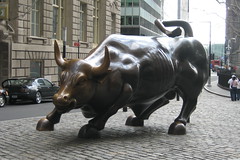 This popular statue was cast in bronze by
Arturo Di Modica
and left by the artist in front of the New York Stock Exchange
on Broad Street in 1987 as an unasked-for Christmas gift
to the city in the wake of a recent stock market crash. The
city impounded the sculpture as a 7,000-pound act of vandalism,
but public support for the artwork and the gesture compelled
the parks department to reinstall it here.
This popular statue was cast in bronze by
Arturo Di Modica
and left by the artist in front of the New York Stock Exchange
on Broad Street in 1987 as an unasked-for Christmas gift
to the city in the wake of a recent stock market crash. The
city impounded the sculpture as a 7,000-pound act of vandalism,
but public support for the artwork and the gesture compelled
the parks department to reinstall it here.
From March 2017 until November 2018 the bull was counterbalanced by Fearless Girl, a statue intended to promote a stock fund that invested in gender-diverse corporations, but which was embraced by the public as a symbol of feminist populism. The statue was removed despite its popularity because its juxtaposition with the bull suggested the messages that maybe unbridled capitalism wasn't so great after all. Bowling Green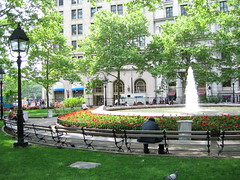
This may or may not have been the site of
the celebrated $24 purchase of Manhattan from
the Canarsie Indians—who in any case got the better
part of the deal, as the island was not actually
theirs to sell. (They lived, as their name suggests, in
what's now Brooklyn.)
By 1733 this spot had been dedicated to the ''Beauty & Ornament'' of Broadway and the ''Recreation & delight of the inhabitants''— recreation in those days often involving lawn bowling (ala Rip van Winkle). In 1765 the colonial governor was burned in effigy here in protest of the Stamp Act. In 1770, a statue of George III was erected here to thank him for repealing that act— only to be torn down (and melted down into Revolutionary musket balls) on July 9, 1776, in celebration of the Declaration of Independence. The present fence dates from that era, and is still missing the decorative crowns that were snapped off by the anti-royalists. |
National Museum of the American Indian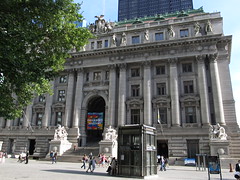
A branch of the Smithsonian, opened in 1994. The former
Alexander Hamilton U.S. Customs House,
designed by Cass Gilbert in 1907 and considered the finest
Beaux Arts building in the city.
The building is on the site of Fort Amsterdam, the Dutch colonial fort first built in 1623. This was the scene of the city's frst recorded murder, on May 15, 1638, when Jan Gysbertsen killed Gerrit Jansen in a knife fight at the fort's gate. Renamed Fort George by the British, it caught fire in 1741, sparking a hysteria about a ''Negro Conspiracy'' that resulted in 18 blacks being hanged and 14 burned alive. The complex was demolished in 1787, replaced in 1790 by Government House, which was intended as a presidential mansion but had to settle for the governor, the nation's capital having moved during construction. |
|
What's missing on Broadway? Write to Jim Naureckas and tell him about it. Sources for the Songlines. NYSonglines' Facebook Fan Page. An extensive 1911 history of Broadway, A Historical Tour of the Greatest Street in the World, is online. Sampling Broadway is a multimedia site about the street. A Walk Down Broadway, with photos of every block, by Vidiot. If you enjoy the New York Songlines, please link to them from your blog or website.
|